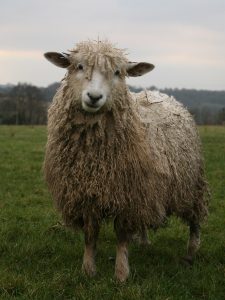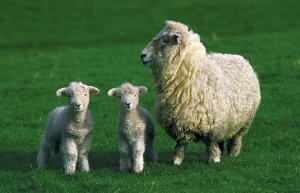Your first thought may have been one, maybe two, but it is estimated that there are more than 200 sheep breeds on earth!
A very surprising fact indeed but true never the less! I’m going to make the wild assumption that you went (or currently go) to school. If I’m right, we all know the basic animals. Pig, cow, chicken and, of course, sheep. And now here i am, ruiner of childhoods, telling you there are over TWO HUNDRED types of sheep!

Sheep are farmed for an extremely wide variety of reasons. From meat and milk to wool and hide, they’re an extremely versatile species. Different sheep breeds fit different sheep needs, with some serving two purposes at once (multitasking geniuses!)
below, I’ll cover the two most well-known reasons for sheep farming in a bit more detail.
Sheep farmed for wool
Let’s start with the most common (and well known) reason sheep are farmed: their wool. Since roughly 4000BC humans have been using sheep wool for clothing. That’s 6000 years of wool farming.
Naturally, as I learned while researching for this blog, there are a million aspects to consider when choosing which sheep breeds to use the wool of. I’ll give a VERY quick rundown here, but i 100% suggest you check out this piece from PetHelpful to get a more in depth run down of this topic.

When considering which breed to use, you have to start with what the wool is for. Outerwear and rugs don’t need the same quality of wool as baby wear or next-to-skin clothing after all. From what i can tell, the softer, finer and more elastic the fibres of the wool are, the better for more delicate textiles it is. A good strength and sheen in your wool fibres makes for an excellent piece of outerwear or a lovely durable rug.
Like i said, this is a SHOCKINGLY complex topic and i urge you to get lost in the wacky world of wool in the link above. Trust me, it’s interesting. Anyway, onto other sheep breeds and products.
Sheep farmed for meat
I once again have to shout out PetHelpful for their bountiful sheep information.
Sheep meat is, once again, a surprisingly complex topic. Of course, their is lamb meat. This refers to the meat of a sheep below one year of age (otherwise known as a lamb). To go further, meat from a sheep aged between 6 and 10 weeks is known as ‘baby lamb’, a fact i find slightly interesting but mostly heart breaking. On the bright side, lamb is delicious on a skewer or in a big greasy kebab so at least they don’t die in vain.

Mutton, on the other hand, is meat harvested when the sheep is around 2 or 3 years old. Mutton tends to be darker and, of course, larger than lamb with a gamier taste. Lamb is generally considered to be more tender and delicately-flavoured.
One breed of sheep commonly kept for meat is the Suffolk Sheep. This is due to it’s large stature. Suffolk ewes reach between 180 and 250 pounds, with Suffolk rams getting up to 350 pounds! A larger stature of course means more meat per sheep. Suffolk sheep also have a higher nutritional value than most meats, as well as a long life span (13 years!) and a hardy nature allowing them to survive in tough conditions.
Extra information
Animal-Club provides animal parties or animal handling workshops. You will be able to see, learn and interact with many wonderful animals with the help of our presenters. Our mobile zoo has many friendly animals such as rabbits, tarantulas, geckos, vinegaroons and more, perfect for an animal party. We can also come over to your school for an animal school visit or arrange for an animal workshop with us where the children can learn about looking after animals and animal behaviour, and have fun too.



